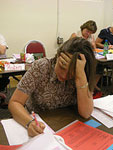Download
Using Non-Linguistic Representations to Strengthen Historical Thinking

The classes at the urban San Diego charter school where I teach are not tracked. As a result, 100% of the juniors on campus are enrolled in AP U.S. History. With a relatively large number of English Language Learners, the challenge is to design a rigorous college-level course that helps students master historical thinking and specific content. I have found that encouraging students to use and produce non-linguistic representations results in deeper thinking and better understanding. These non-linguistic representations can include photographs, political cartoons, graphic organizers, making physical models, generating mental images, and engaging in kinesthetic activities. The use of non-linguistic representations provides students with the chance to illustrate their understanding, ask new questions, refine their thinking, make connections, organize key concepts, and create mental images without being overly concerned about grammar, spelling, and their English proficiency. In addition, as I review visual images drawn by students and listen to their explanations or hear students describe their interpretation of a political cartoon, I often have a much clearer idea of what a student comprehends as well as the skills and content that need more review. There are a number of ways to begin integrating the use of non-linguistic representations into a history classroom to encourage historical thinking:
- Foster opportunities for collaborative learning, encouraging students to work together to construct and design non-linguistic representations that express what they know.
- Ask students to generate mental images, use graphic organizers (e.g. Venn diagrams, concept maps, time sequence webs), or draw pictures.
- Incorporate multiple opportunities for students to analyze photographs, political cartoons, or music from the time period and topic being studied.
- Model for students how visual imagery, auditory resources, or kinesthetic activities can express what one knows. Provide scaffolds for students as you incorporate graphic organizers, idea webs, political cartoons, and other non-linguistic resources and activities into your lesson plans.
By introducing these types of learning experiences, students have multiple opportunities to use questioning techniques that help them refine and synthesize what they know.
As a culminating assignment at the end of our unit on antebellum America, students in my AP U.S. History class write an essay answering the following prompt:
Analyze the ways in which controversy over the extension of slavery into Western territories contributed to the coming of the Civil War.
I use non-linguistic representations in specific ways during this unit to help students construct an analytical understanding of the time period and prepare for this writing assessment.
- At the start of the unit, students are assigned a particular historical character (e.g., Harriet Tubman, William Lloyd Garrison, Steven Douglass, John C. Calhoun). As we read various primary and secondary sources, students record on a graphic organizer how their character would respond to the source and why. While we read a number of text-based sources, I purposefully incorporate various non-linguistic sources (e.g., political cartoons, photographs, and in later units musical recordings). In this case, students worked with political cartoons, including this 1856 cartoon, this one, and this one.
- Towards the end of the unit, I pose a series of questions to students to prepare them for the essay prompt they will address. These questions include:
-
- Should slavery have been allowed to extend into the West?
- Should the federal government or state governments have made this decision and why?
- Was the Dred Scott decision an accurate interpretation of the Constitution?
- As each question is asked, students move to different pre-assigned corners of the room depending on how their historical character would respond. In their initial groups, students explain why their character answered in this particular way and then share their character’s perspective with the entire class. I also provide time for structured debate between students. Being able to visualize the sectional divide and hear the various responses helps students process the strong regional tensions.
-
- Each student is then given a graphic organizer where we brainstorm events, people, and legislation that impacted the tensions over the westward expansion of slavery in the United States.
- The last step is to have students design and draw a non-linguistic representation (a political cartoon or symbol) that illustrates the controversy over the extension of slavery and the particular events, people, and/or acts of legislation that heightened this tension. Accompanying this visual is a written explanation. See a sample of student work.
After completing these activities over a few class periods, students begin the process of outlining and writing their essay response. Having the opportunity to utilize both linguistic and non-linguistic methods for representing knowledge and thinking about historical events often gives students, particularly our English Language Learners, a stronger ability to make connections between claims and evidence, recognize bias, and synthesize this understanding in a written format.
